
 |
|
|
#1 |
|
Member
Join Date: Dec 2008
Posts: 84
|
Hi Friends,
I have been puzzling over the following item for while. Thought of posting it here to see what ideas / free associations?? might come up. The object is steel with a rounded javelin type head and an octagonal haft. The heavy rounded head looks like it was intended to shatter and smash what ever it came into contact with. The silver inlay carries the dash, the cross and the 'v' or the inverted 'v'. Note the crisscross marking at the begining of the haft. Looks like it was inteded to be attached to something or had something attached to it. Probably the head of some sort of projectile or pike. But a pike with a rounded heavy head seems pointless unless projected in some manner. At the time it was acquired, the haft had a thin loose fitting metal sleeve about 2 Cm in length. Provenance - Sri Lanka. Thank you. Regards. |
|
|

|
|
|
#2 |
|
Arms Historian
Join Date: Dec 2004
Location: Route 66
Posts: 10,736
|
Bump
|
|
|

|
|
|
#3 |
|
Member
Join Date: Oct 2007
Posts: 2,818
|
An interesting bump, it is a shame when mind bending posts go unanswered, great to see it bought forth.
With the notation of there being a small sleeve once with it, it does look as though it could slip in to a bamboo shaft and have the ring squeeze it in place??? Another thought that can to mind with the shape was a sort of a basic hand dart, not for throwing but for fighting with in the hand? It is something that may not kill someone but certainly subdue. Some random thoughts. Gav |
|
|

|
|
|
#4 |
|
Member
Join Date: Jan 2008
Posts: 1,429
|
Just a wild guess - but could it be some type of elephant goad or similar ? Fixed in a bamboo shaft, the octagonal cross section would prevent turning, also the metal sleeve...
Elephants were used in Sri Lanka for haulage, hunting etc., were they not ? Regards |
|
|

|
|
|
#5 | |
|
Member
Join Date: Oct 2007
Posts: 2,818
|
Quote:
Gav |
|
|
|

|
|
|
#6 |
|
Arms Historian
Join Date: Dec 2004
Location: Route 66
Posts: 10,736
|
Hi Gav and Colin,
Excellent observations on this extremely unusual object, and I completely agree Gav, it is truly a shame when these intriguing subjects simply fall away without any effort or suggestion toward discovering what they might be. The reason I bumped this forward was to instigate more discussion, and to note the possibility that has been suggested to me by research done by Anandalal. I had not yet added the subsequent material as I was still compiling notes and should have bumped the thread with notes added  Apparantly in early forms of cannon, there were varying types of projectiles along with, of course, many prototypes of devices to propel these using the then innovative use of gunpowder. According to descriptions of such early forms of 'artillery' in the 1932 work of J.L.Boots ("Korean Arms and Armour"), one such projectile fired from a 'fire tube' was a huge arrow, sometimes nearly 6 feet long. These had a heavy iron point or head of up to between 4 and 5 lbs. Although I'm not sure of the size of this example, it should be noted that in some cases there were numerous arrows fired simultaneously and of course commensurately smaller, which would correspond with Gav's observation as well of insertion into a bamboo shaft. These appear to have been in use along with many variations in both the type of propulsive weapon detonating the gunpowder, and the type of projectile(s) from about latter 15th and into 16th century in Korea, which seems of course relatively late considering much earlier use in China and Europe of gunpowder in warfare. As noted, this iron object is provenanced from Sri Lanka, and there does seem the distinct possibility this might be the head component of one of these type of early projectiles. Naturally the question is what type of weapons firing these type 'arrows' might have been used there, and does this correspond to known data such as narratives, artwork or provenanced similar items that might better identify it. With this perspective giving better view of the direction headed in the search for identification, I hope we can continue with observations and ideas. All best regards, Jim |
|
|

|
|
|
#7 |
|
Member
Join Date: Dec 2008
Posts: 84
|
Thanks Jim for that introduction Clearly there is no way of confirming this. Let me add the following info. to the discussion for now. Ribeyro a professional soldier arrived in Ceylon (Sri Lanka) in 1640 and his book Fatalidade Historica is dedicated to the King of Portugal on 8th January, 1685. Writing of the early period of Portuguese in Sri Lanka he writes as follows:
"All pretence was now cast aside and they commenced to besiege us ... a host of twenty thousand men was soon assembled, two bastions were hastily erected with the help of palm trees and mounted with cannon, while more than six hundred large muskets of the size of small cannon hurled against our walls wooden darts ten palms long by day and fire lances by night." - Translated from the original Portuguese by P. E. Peiris in Ribeiro's History of Ceilao (1909) Yes it talks of wooden darts but ten palms long. I believe Fernando explained the length of a palm in another post and this makes the dart over 6 feet in length. The blunt heavy head of this artefact can only have an impact if hurled with great force. The weight of the artefact is approximately 450 grams. By the way, the elephant goad or ankus is out. The ankus has to have a recurved prong for pulling on the pressure points of the elephant. If you watch a mahout in action you will see that he rarely uses the forward faced point which in fact is only used to protect oneself should the elephant turns suddenly towards him i.e. to push the elephant away from oneself. Regards. |
|
|

|
|
|
#8 |
|
Member
Join Date: Dec 2008
Posts: 84
|
Rebeiro's comment relates to the year 1519.
|
|
|

|
|
|
#9 |
|
Member
Join Date: Jun 2008
Location: The Sharp end
Posts: 2,928
|
well, this is a strange item.
The shape, with the flattened side of the 'ring' facing the long 'pin' end makes me wonder if this could be some form of Belaying pin. I've heard of Iron belaying pins before, and varying sizes for smaller vessels. Also of course, the belaying pin was often an improvised weapon, could it be that this is a pin 'designed' to double as a weapon? Or just a posh form? What is the black stuff on the surface? A rustproofing coating? Of course thats not really explaining the sleeve. |
|
|

|
|
|
#10 |
|
Member
Join Date: Jul 2009
Posts: 607
|
Some kind of masonry implement?
|
|
|

|
|
|
#11 |
|
Member
Join Date: Jan 2006
Location: Kent
Posts: 2,658
|
I'm wondering whether this is a lance head.....why waste silver on a projectile, that in all likelyhood, you would never retrieve. I think the raised 'ring' is possibly a way of weighting the end for better balance or to help prevent penetrating too deeply. Bamboo would be an excellent shaft for a lance and a galloping horse would surely provide the necessary momentum, to do some serious damage to its target. A very sharply pointed lancehead may be a disadvantage in that it would be deeply imbedded after hitting the unfortunate victim
 and difficult to retrieve whilst on horseback. and difficult to retrieve whilst on horseback.A few pictures...for the fun of it. The lancers on foot is from a painting entitled CHARGING ON FOOT WITH THE LANCE: BENGAL LANCERS ATTACK GERMAN TRENCHES.—From the Painting by R. Caton Woodville. Regards David . Last edited by katana; 7th January 2010 at 08:12 PM. |
|
|

|
|
|
#12 |
|
Member
Join Date: Jan 2008
Posts: 1,429
|
Hi
Interesting set of views on this. It seems unlikely that a projectile for an early cannon would have silver inlay to the point.... Its probable that the part with the silver is meant to be displayed, and could be a handle, the octagonal bit (as already noted), likely would be inserted into a handle or shaft, the shape preventing turning. Some other possible applications could be :- a) Handle for a flag or other processional item b) Finial to a standard of some sort c) Handle (one of four corners) of a palanquin or a large deity carried in procession (inserted into an octagonal slot). Regarding elephant goads, it seems not all had hooks, a quick troll on google shows this example described as "a fine Sri Lankan rosewood brass and steel elephant goad and sword stick" I wonder if the silver inlay symbols have any local Sri Lanka meaning ? Regards Colin |
|
|

|
|
|
#13 |
|
Arms Historian
Join Date: Dec 2004
Location: Route 66
Posts: 10,736
|
I am wondering of the silver inlays might have been emplaced at a later time, perhaps after this weapon/component had been taken out of use and if it might have become a votive object? It does seem that in many cases that weaponry did become holdings in temples and monasteries, for example in Tibet (not suggesting this is Tibetan, just an instance) which served as revered objects for various purposes.
As has been noted, it does not seem that silver would have been inlaid in a tool or weapon, especially something which would have been lost in battle. If the item was no longer in service, but became venerably associated with any number of events, person, purposes etc. perhaps symbolic marks might have been applied? All best regards, Jim |
|
|

|
|
|
#14 |
|
Member
Join Date: Dec 2008
Posts: 84
|
Great input and thanks.
Yes I can see the logic of not using silver in a projectile that one would be unlikely to retrive. Let me add the following observations with my attempt at explaining them. (a) The raised ring A1-B1 has a flat surface towards the octagonal section which we assume is where the shaft was fixed. Hence the obvious reason would be to prevent the shaft sliding forward in the event of a hard impact. (b) The octagonal part shows that anteriorly i.e. just after the raised ring it is narrow and gradually widens towards the posterior, becoming slightly narrow once again at the furtherst end. If this is intentional, once the sleeve is in place, it would prevent the head flying off leaving the shaft behind in the event of a forward motion applied to the shaft. On the above observations I am of the opinion that it was projected in some way with some force though that does not automatically relate it to the cannon situation. Of course that does not explain the silver inlay unless there was some talismanic object as Jim has indicated. I assume the previous discussion on gun arrrows at http://www.vikingsword.com/vb/showthread.php?t=7158 and in particular the link http://www.koreanarchery.org/classic/bhwangja.mpg would have been looked at where in the winged arrow, the head is sunken into the shaft. I cannot open the other links therein. Best Regards. |
|
|

|
|
|
#15 | |
|
Member
Join Date: Oct 2009
Location: Gyeongsan, South Korea
Posts: 57
|
Quote:
http://www.koreanarchery.org/classic/bhwangja.mpg http://www.koreanarchery.org/classic/heonja.mpg http://www.koreanarchery.org/classic/jija.mpg My doctoral dissertation is on firearms in Joseon dynasty Korea (1392-1910). The first recorded use of a firearm in Korea was in 1356 when an arrow cannon was fired for the king to see. |
|
|
|

|
|
|
#16 |
|
Member
Join Date: Dec 2008
Posts: 84
|
Dear Bluelake,
That is extremely interesting. Thank you very much for providing the updated links. I have also sent you a PM. Regards. Anandalal. |
|
|

|
|
|
#17 | |
|
(deceased)
Join Date: Dec 2004
Location: Portugal
Posts: 9,694
|
Quote:
 . .Fernando. |
|
|
|

|
|
|
#18 |
|
Member
Join Date: Dec 2009
Posts: 140
|
Hello,
i was with my friends this weekend and i couldnt believe my eyes. This part of an old SINGER sewing machine looks quite similar to this "projectile". It is made of wood and sticks in the desk of the machine. We dont know for which it will be used on it but maybe of assorting the cloth. Because of the existing textile industrie in Sri Lanka your Item could be a part of an industrial sewing machine and it will explain the decoration on it; Singer do so too with his machine itself. best regards Dirk |
|
|

|
|
|
#19 |
|
Member
Join Date: Oct 2009
Location: Gyeongsan, South Korea
Posts: 57
|
Here are a couple pictures from items in the Korean Army Museum.
The first is of 19th century Korean police clubs (the third one looks a lot like the OP's item) and the second is of points that went on the Korean cannon projectiles.  
|
|
|

|
|
|
#20 |
|
Member
Join Date: Dec 2008
Posts: 84
|
Thank you all for the insight.
Bluelake, I assume all three Police clubs are wooden? Is the third one a "Yawara" type weapon instead of a club? The iron arrowheads are facinating. Obviously secured by a pin throught the tang? Has any dating been done? Thanks. Anandalal N. |
|
|

|
|
|
#21 | |
|
Member
Join Date: Oct 2009
Location: Gyeongsan, South Korea
Posts: 57
|
Quote:
The projectile points just say "Joseon dynasty" in Korean, which could mean any time between 1392-1910, although I know that type of weapon was used from early Joseon at least on up through the Hideyoshi invasion of 1592-1598. |
|
|
|

|
|
|
#22 |
|
Member
Join Date: Jan 2005
Posts: 478
|
Looks a little like a belaying pin to me.
|
|
|

|
|
|
#23 |
|
Member
Join Date: Oct 2009
Location: Gyeongsan, South Korea
Posts: 57
|
Here are a couple of pictures I took a while back of the "arrow" cannon at the Korean Army Museum.
 
|
|
|

|
|
|
#24 |
|
Member
Join Date: Oct 2009
Location: Gyeongsan, South Korea
Posts: 57
|
I revisited the Korea Military Academy the other day and took a few more pics of the cannon arrows.
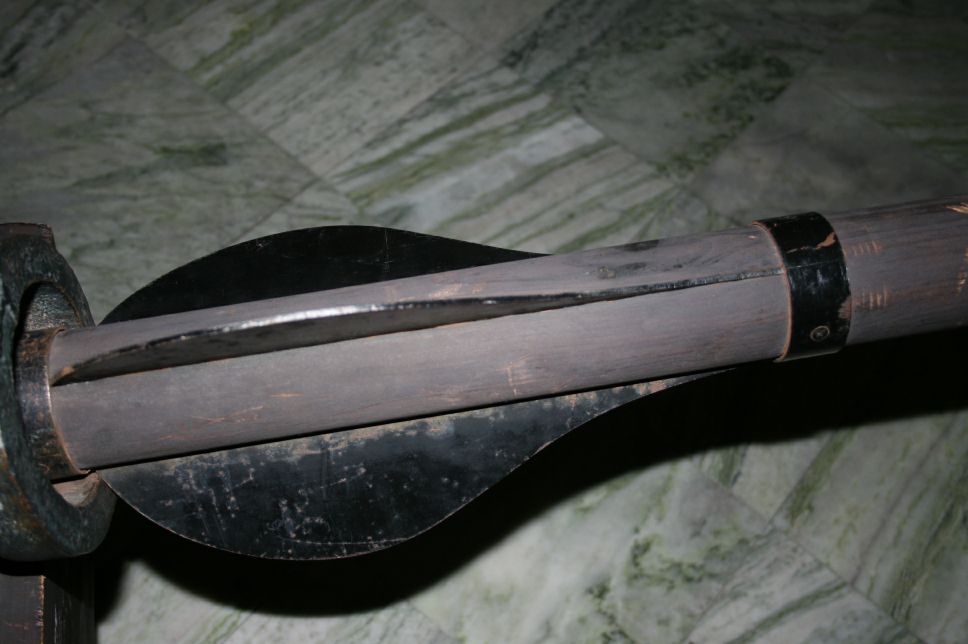 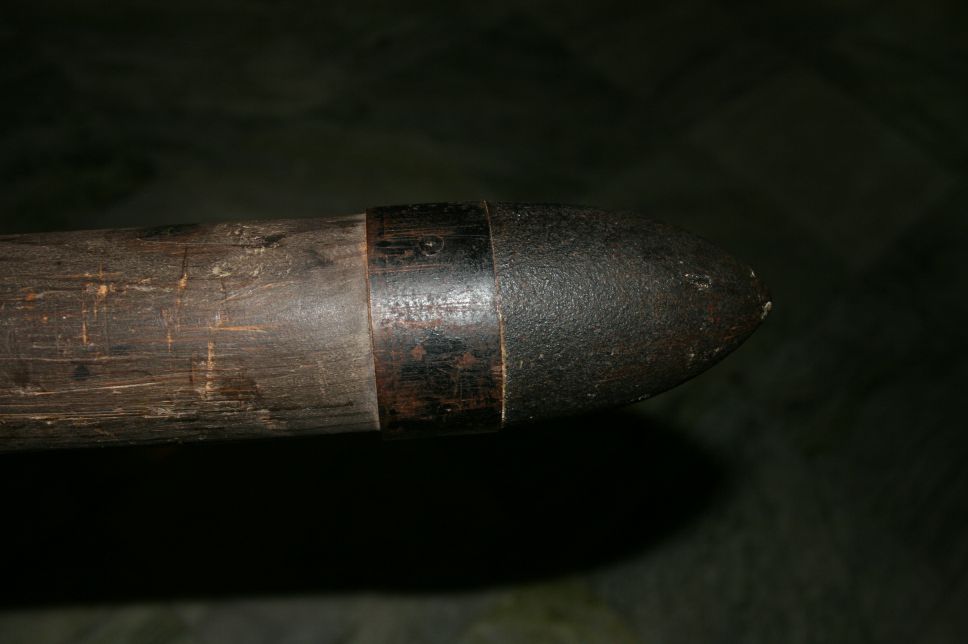 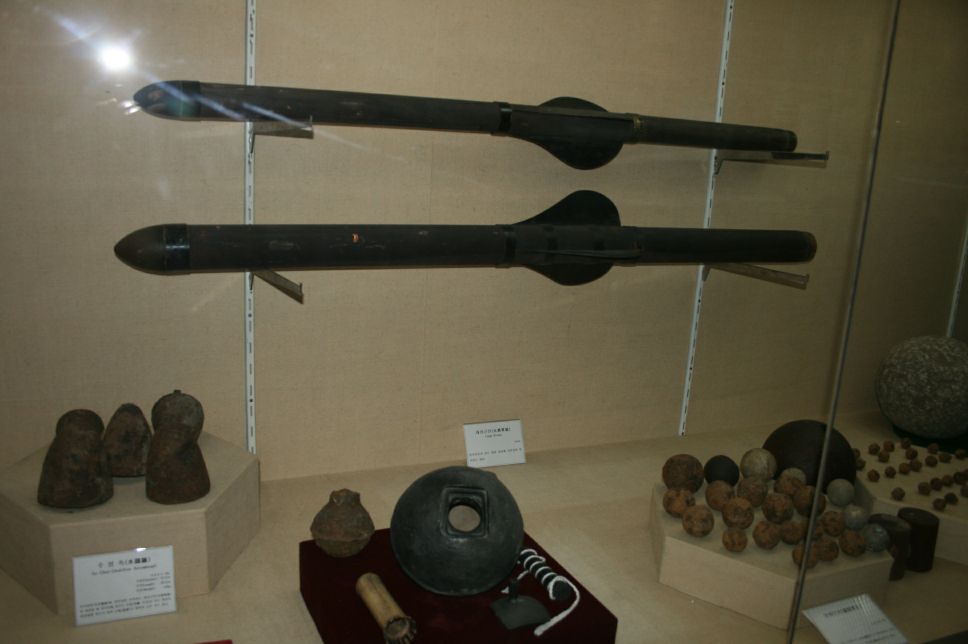 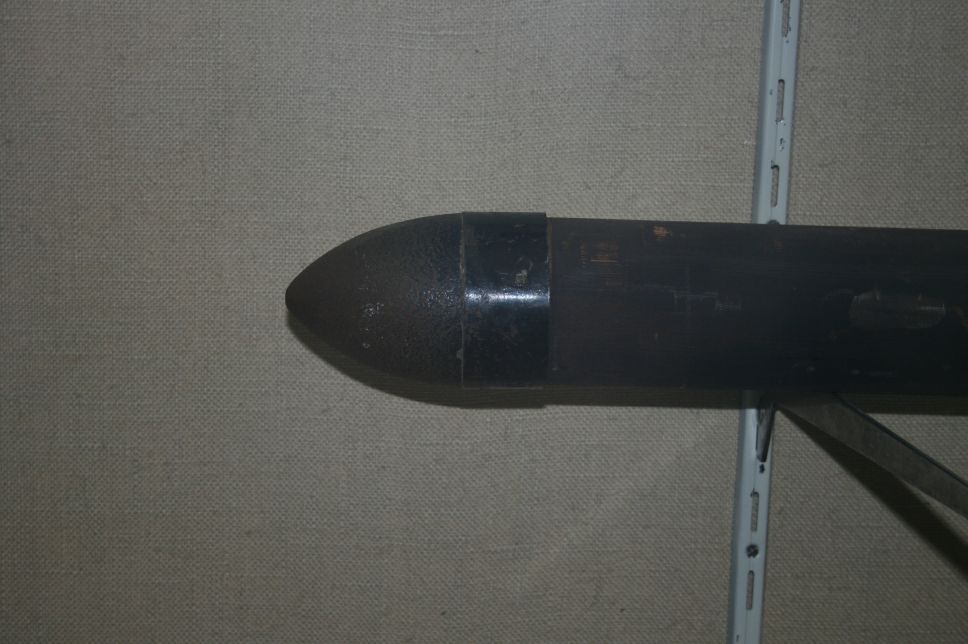 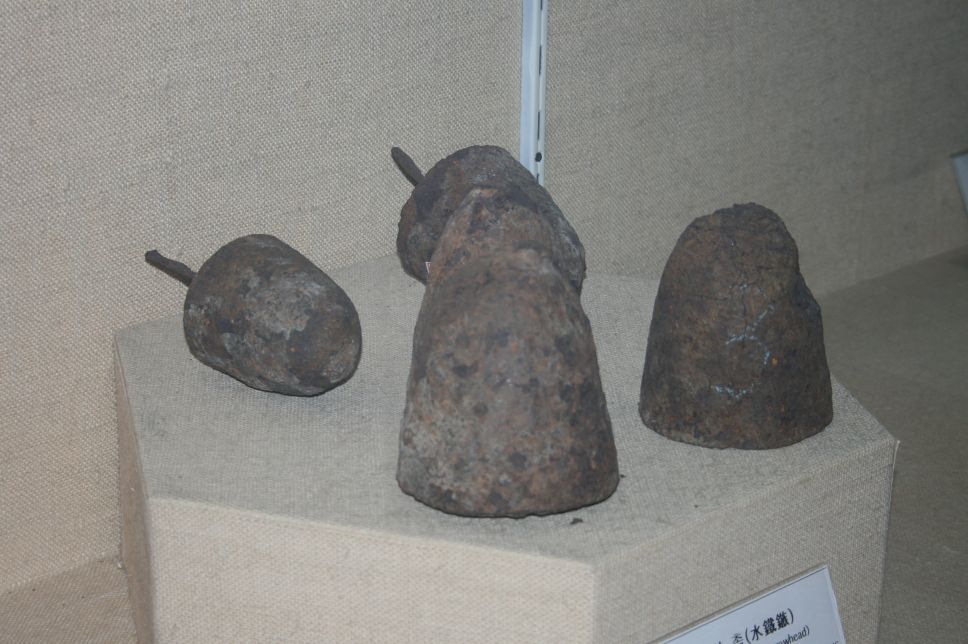
|
|
|

|
|
|
#25 |
|
Member
Join Date: Dec 2008
Posts: 84
|
Dear Bluelake,
Thank you for these additional images. As you can see your images throw light on the Milemete cannon arrow for there was much specualtion as to why it shows the fletching at the muzzle of the cannon. Your illustrations show that the fletching is halfway up the arrow and not at the rear end as in an arrow used on a bow be it a long bow, crossbow or other types of bow. As always I look forward to your information in this regard. Regards. |
|
|

|
 |
|
|